Meet John Green, the 42-year-old, single, surfer, fit, gluten-free target customer for the 2018 BMW 530e iPerformance, the newest plug-in-hybrid version of the 5-series.
He’s a startup star in L.A.’s Silicon Beach, where he stands around the office froyo machine discussing disruption, the firm’s desire to float an IPO, and the CEO’s McLaren P1. Green is image conscious, socially aware, and—when he isn’t flying to Vegas for dinner—environmentally friendly. His Toyota Prius, his third in a row, is no longer cutting it. The last venture round went well, and Johnny wants to treat himself to something new. Something that looks more at home in the garage next to the Porsche 911 Targa that he drives around Manhattan Beach on the weekends. He’s going to love the 530e.
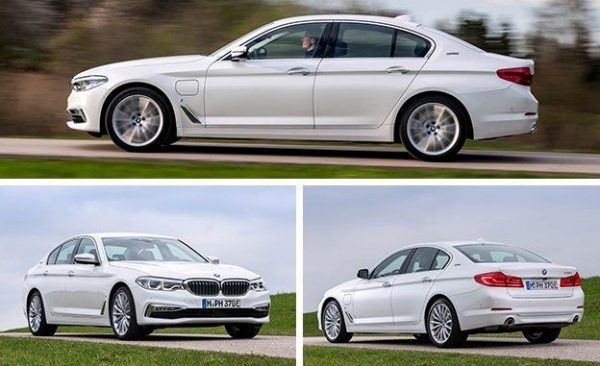
Batteries Must Work
BMW claims that it’s now the third-largest supplier of electrified cars in the world, even if total volume in America remains quite small. The company’s eDrive system—which combines its turbocharged, direct-injected 2.0-liter inline-four with an electric motor and a 9.2-kWh lithium-ion battery pack—has now found its way across much of the German luxury brand’s lineup, including the 3-series, 7-series, and X5 SUV.
In the 530e, the four-banger is rated at 180 horsepower and 255 lb-ft of torque and the electric motor at 111 hp and 184 lb-ft, for a combined output of 248 hp and 310 lb-ft. That matches the stated totals for the 330e plug-in hybrid, but it’s quite a bit less than the output claimed for the larger and heavier 7-series plug-in and the X5 xDrive40e.
They all use the same ZF-supplied eight-speed automatic transmission, but the torque converter is replaced by the electric motor. Having it in this position just upstream of the transmission allows its ratios to be used in all-electric mode, which keeps the 530e from feeling like a leather-lined golf cart.
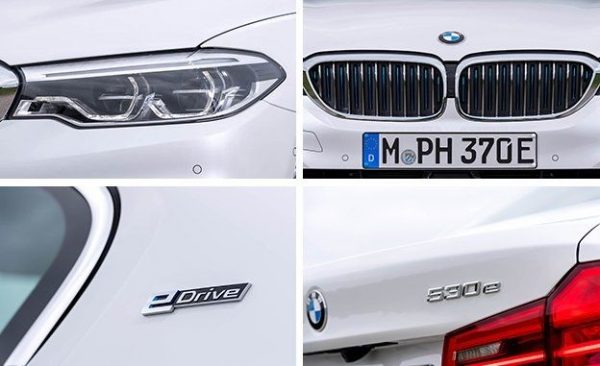
Although it’s slow compared with any Tesla Model S, the 530e will dust Green’s Prius, and it’ll keep up with his neighbor’s 530i. BMW claims a zero-to-60-mph time of 6.0 seconds for the rear-wheel-drive 530e and 5.8 seconds for the xDrive all-wheel-drive model, matching the times for the standard, gasoline-only 530i. Top speed is 146 mph, according to BMW.
In the freezing rain on the unrestricted section of Autobahn 8 east of Munich, we saw 130 mph. We were impressed by the car’s ability to get there quickly as well as its stability considering the weather and the snow tires fitted for Bavaria’s lingering winter. The 18-inch wheels wear 245/45 run-flat all-season tires as standard.
No Anxiety Here
The 530e will travel about 30 miles on electric power alone at speeds up to 87 mph. That is, it will if you never put the gas pedal on the floor. Leadfoot the throttle and the 2.0-liter joins in, but the transition is seamless. The turbo four turns on and off so smoothly you don’t feel it, and it’s very quiet. At low speeds, you’ll completely miss its operation if you have the radio on. BMW says charging takes three hours when plugged into a 240-volt outlet and less than five hours on a standard 120-volt wall socket. But it’s a hybrid, so total range is about 400 miles before you even have to think about charging.
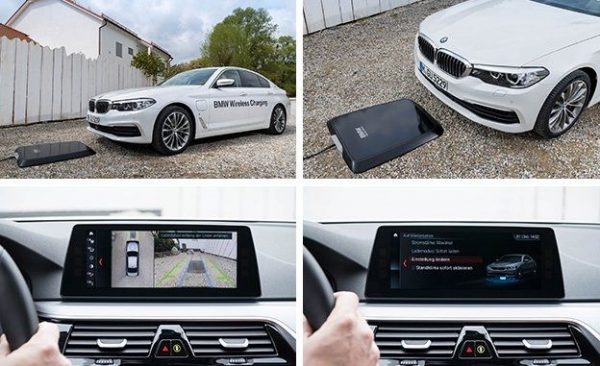
We almost said “before you even have to think about plugging it in.” But a wireless charging system is on its way, and BMW expects it to be very popular. Parking the car atop an inductive-charging pad, which can be installed indoors or out, generates an alternating magnetic field with a secondary coil integrated into the underside of the car (the two never touch). BMW says it’ll take about 3.5 hours for a full charge. Unfortunately, the pad itself is not yet past the prototype stage of development. BMW expects it to be approved for production in 2018—when it is, the in-car technology will be waiting.
The big battery pack does encroach into the sedan’s trunk space. Cargo volume drops from 19 cubic feet in gasoline models to 15 in the PHEV, but BMW managed to retain the split fold-down rear seat. The gas tank is smaller, too, down to 12 gallons from 18.
Every Mode of a Modern Motor/Generator
This is a BMW so there are settings—lots of settings. There’s the usual Driving Dynamics Control with Eco Pro and the default Normal mode, plus Comfort and Sport alternatives, which basically change the rate and readiness of the gas engine’s involvement. In Sport, the gauges glow red and the engine is always on, adding power.
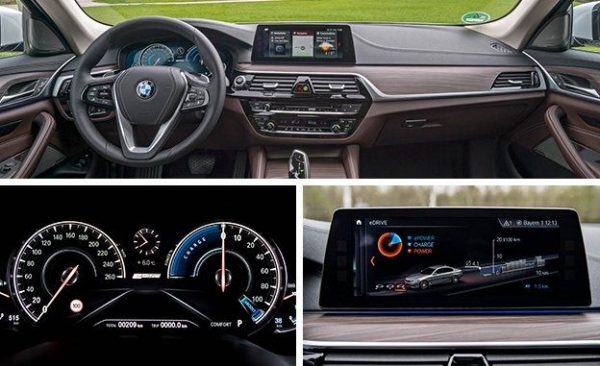
The eDrive button adds three modes for managing the battery. In the default Auto eDrive mode, the powertrain optimizes the interaction of the two power units depending on the driving situation. Max eDrive puts the car in electric mode all the time, unless you press through a detent in the throttle’s travel, when the gas engine will fire up because you’ve demanded more acceleration than the electric system can deliver. Battery Control mode allows you to save a determined level of battery power for later or even charge the batteries as you drive.
We don’t expect Johnny Green to dive into those selections often, although it would be sinful for him not to play with Sport mode and manipulate the 530e’s eight-speed automatic with the standard paddle shifters. When the driver does that, the transmission matches revs on the downshifts and the car almost feels like a standard gasoline 5-series. While the 530e has regenerative braking, it is not as strong as it is in most electrified cars, including the BMW i3. Back off the throttle and the 530e coasts freely like the cars we’re all familiar with driving.
Hypermilers may appreciate the graphic coaching prompts built into the gauge cluster to aid in maximizing the car’s efficiency. It shows a little arrow pointing up at a foot, telling you to back off when it thinks you’re having too much fun. And at the end of the journey you’re given a one-to-five-star rating based on how lightly you accelerated and other dynamics. It’s all easily ignored, if you so choose. We scored one star on our drive.
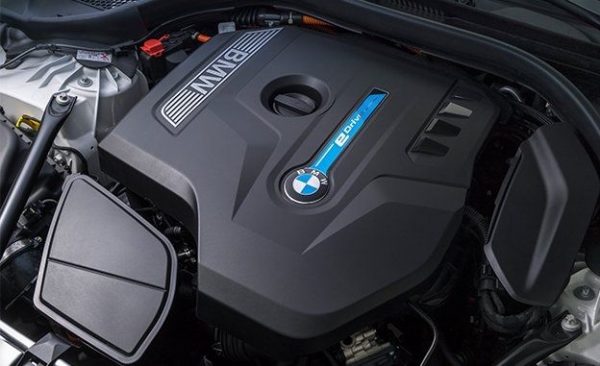
Weight is up compared with that of the gasoline-only 530i, but BMW has done a masterful job of hiding the additional 500 or so pounds. The ride is supple, and the sedan’s balance hasn’t been compromised. With more weight lower and in the rear, the weight distribution is even better than other 5-series variants, and it certainly has a lower center of gravity. We were able to maintain a satisfying pace over the twisting two-lane roads south of Salzburg in a rear-wheel-drive 530e, but the weather kept us from pushing hard.
Blue kidney-grille slats, blue rings around the BMW roundels on the wheels, assorted badges, and the charge door on the driver’s-side front fender distinguish the 530e from the rest of the line. Otherwise, it’s standard 5-series down to its dual exhaust pipes.
Now How Much Would You Pay?
The car is sold globally, but BMW expects that Americans like our Mr. Green will be the largest market for the 530e, which already is on sale. For a while, it enjoys a monopoly among German-built mid-size luxury sedans as Mercedes-Benz and Audi drag their feet on plug-in-hybrid versions of the E-class and the A6. The 530e iPerformance costs about $10,000 less than BMW’s former ActiveHybrid 5 (which had a turbocharged inline-six handling the gas-engine duties and boasted 335 combined horsepower). Whereas the ActiveHybrid 5 topped the pyramid for non-M 5-series sedans, the new 530e slots between the 530i and the 540i in the lineup, and it costs just $200 more than the 530i. Pricing starts at $52,395 with rear-wheel drive, and xDrive all-wheel drive adds $2300.
That makes this car a bargain—with more peak torque and better fuel efficiency—even before factoring in any applicable government tax incentives or fuel savings. Mr. Green is going to look sosmart.
 Yaspan Tech, Computers, Gadgets, Reviews, News and Analysis
Yaspan Tech, Computers, Gadgets, Reviews, News and Analysis





